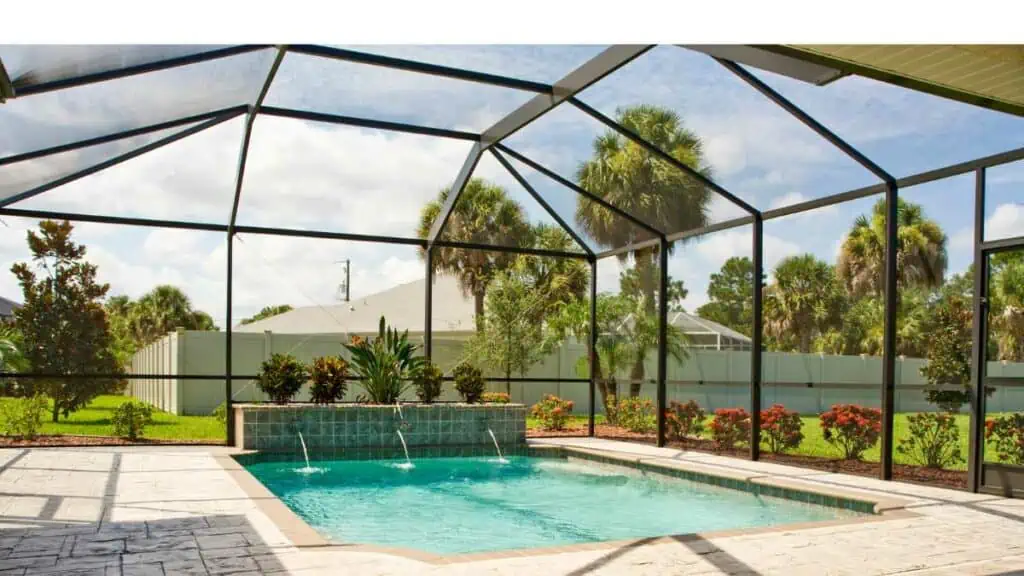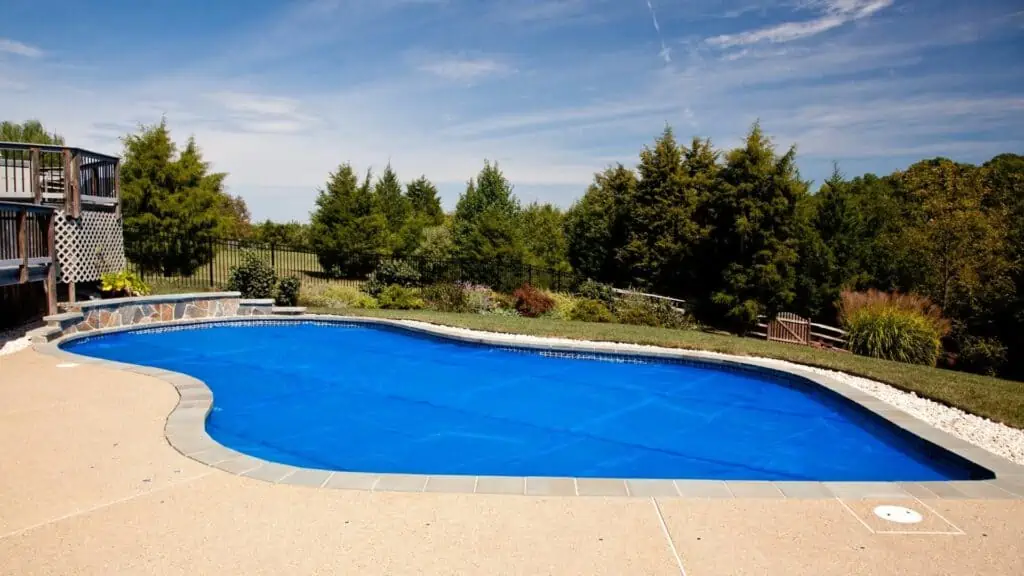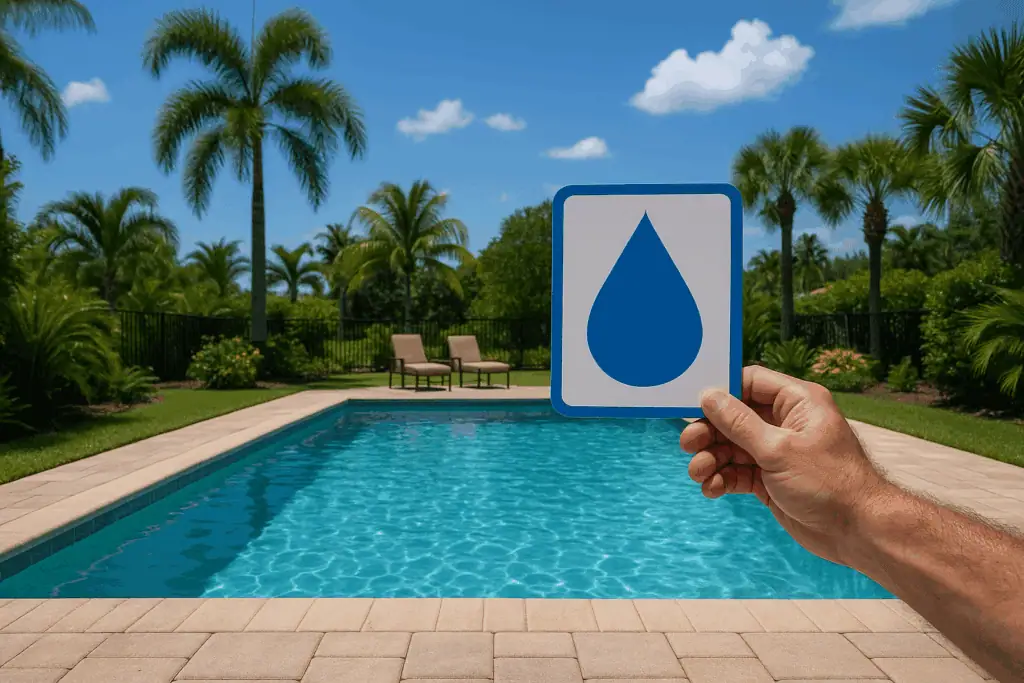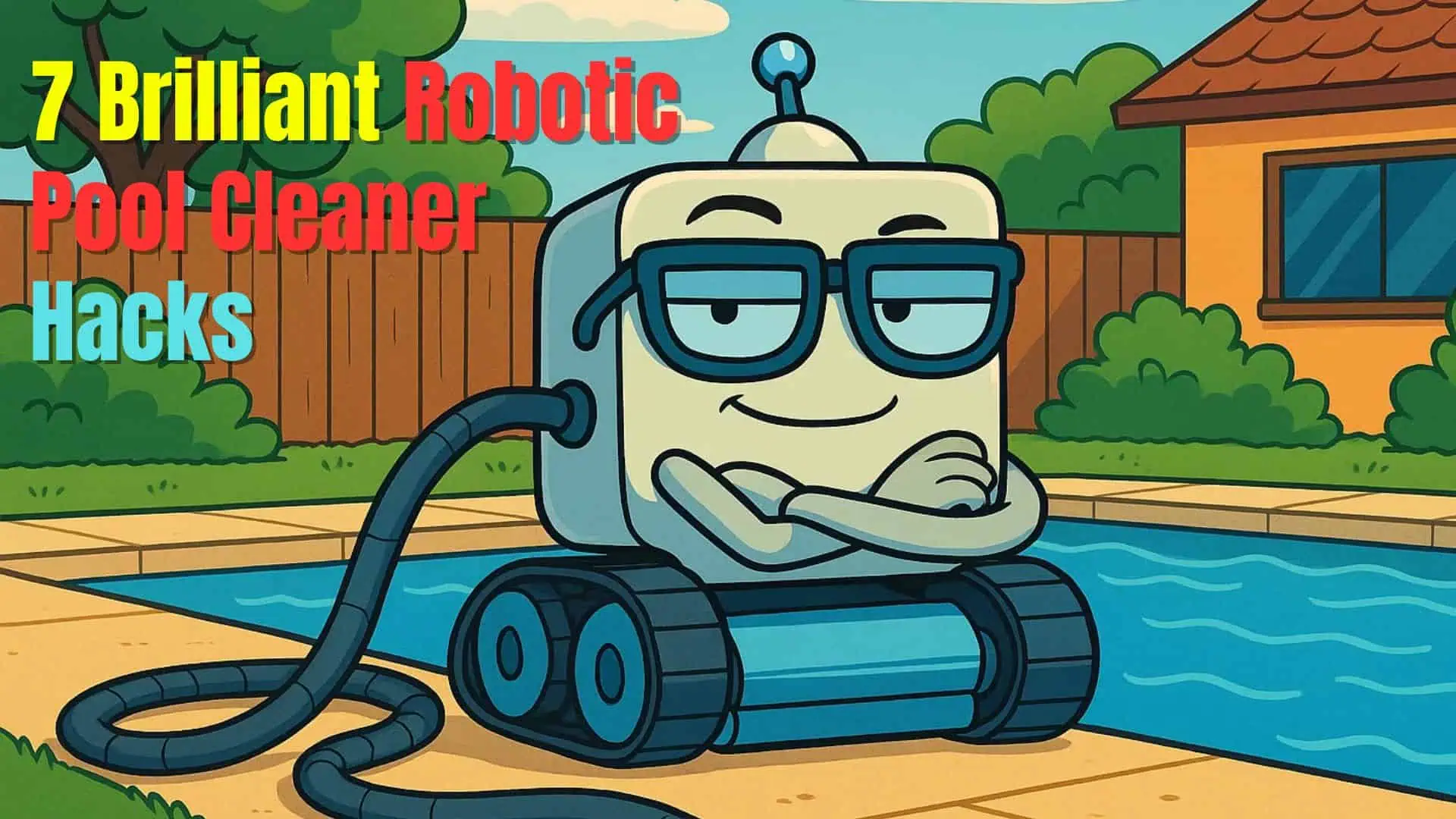This article aims to empower Florida pool owners with practical strategies to reduce water evaporation, conserve resources, and maintain optimal pool conditions.
By implementing these tips, homeowners can enjoy their pools while contributing positively to environmental conservation and potentially reducing their expenses.

Florida’s endless sunshine and warm climate make swimming pools a cherished part of life, whether you’re cooling off in Miami’s urban sprawl or relaxing in a suburban Orlando backyard. However, the state’s intense heat, high humidity, and relentless sunlight accelerate pool water evaporation, leading to significant water loss.
On average, Florida pools lose 1/4 to 1/2 inch of water daily due to evaporation alone—potentially thousands of gallons monthly. With freshwater resources under strain from population growth and tourism, conserving pool water is both an environmental necessity and a way to reduce utility bills.
Below, we outline essential strategies to save water, maintain a sparkling pool, and contribute to a sustainable future in Florida.
Table of Contents
Key Water Conservation Tips
Implementing the following practical tips can drastically reduce water loss while keeping your pool in top condition.
Start with these actionable steps:
1. Install a Pool Cover

A high-quality, fitted pool cover is the single most effective way to minimize evaporation, cutting water loss by up to 95%. Covers also block debris, reducing cleaning frequency and chemical use. For example, a 20×40-foot pool in Tampa could save 10,000–15,000 gallons annually with a cover. Choose durable, UV-resistant materials for Florida’s harsh sun.
Read our article: Solar Pool Covers Guide
2. Check for Leaks Regularly
Leaks can waste thousands of gallons before you notice. Conduct a bucket test to differentiate between evaporation and leaks: place a bucket filled with pool water on a pool step, mark the water levels inside and outside, and compare after 2–3 days. If the pool loses significantly more water than the bucket, consult a professional to locate and fix leaks in plumbing, liners, or fittings.
3. Maintain Optimal Water Levels
Keep water at the midpoint of the skimmer to ensure efficient pump operation. Too low, and the pump may suck in air, straining equipment; too high, and skimming effectiveness drops, leading to debris buildup and potential water waste during cleaning.
4. Upgrade to Water-Efficient Equipment
Replace outdated single-speed pumps with variable-speed models, which adjust flow to save energy and water. Cartridge filters, unlike sand or diatomaceous earth (DE) filters, require less frequent backwashing, conserving hundreds of gallons per cycle. These upgrades often qualify for local rebates.
5. Minimize Backwashing
For pools with sand or DE filters, backwash only when the pressure gauge shows a 10–15 psi increase above normal. Over-backwashing wastes water unnecessarily. Consider switching to a cartridge filter for even greater savings.
6. Use Eco-Friendly Cleaning Solutions
Robotic pool cleaners or automated systems reduce reliance on water-intensive manual cleaning and heavy chemical treatments. These devices efficiently scrub surfaces and filter debris, saving water and energy while maintaining water clarity.
Water Saving Summary
Below is a table summarizing the various water-saving strategies outlined in the expanded article for pool water conservation in Florida. The table organizes each strategy with its description, estimated water savings (where applicable), implementation difficulty, and additional benefits to provide a clear, at-a-glance reference for Florida pool owners.
| Water-Saving Strategy | Description | Estimated Water Savings | Implementation Difficulty | Additional Benefits |
|---|---|---|---|---|
| Use a Pool Cover | Install a fitted, UV-resistant pool cover to reduce evaporation and debris entry. | Up to 95% of evaporation loss (10,000–15,000 gallons/year for a 20×40 ft pool). | Low to Moderate (initial cost, easy to use with retractable models). | Reduces chemical use, debris cleanup, and heating costs. |
| Check for Leaks | Perform a bucket test to identify leaks in plumbing, liners, or fittings; fix promptly. | Varies (potentially thousands of gallons monthly for undetected leaks). | Low (bucket test is simple; repairs may require a professional). | Prevents equipment damage and costly water bills. |
| Maintain Optimal Water Levels | Keep water at the skimmer’s midpoint for efficient pump and skimmer operation. | Hundreds of gallons by avoiding pump strain or overfilling. | Low (requires regular monitoring). | Extends pump lifespan, improves debris removal. |
| Upgrade to Efficient Equipment | Use variable-speed pumps and cartridge filters to optimize water and energy use. | Hundreds to thousands of gallons/year (less backwashing with cartridge filters). | Moderate to High (upfront cost, may need professional installation). | Lowers energy bills, may qualify for rebates. |
| Limit Backwashing | Backwash sand/DE filters only when pressure increases by 10–15 psi. | 100–500 gallons per avoided backwash cycle. | Low (requires monitoring pressure gauge). | Reduces filter wear, saves time. |
| Use Eco-Friendly Cleaners | Employ robotic or automated cleaners to reduce manual cleaning and chemical reliance. | Hundreds of gallons by minimizing water-intensive cleaning. | Moderate (initial investment in equipment). | Saves energy, maintains water clarity. |
| Monitor Chemical Balance | Test pH, alkalinity, and chlorine weekly to prevent algae or scaling. | Thousands of gallons by avoiding draining for cleanup. | Low (requires test kits and routine checks). | Enhances swimmer comfort, reduces maintenance costs. |
| Shock at Night | Add chlorine/shock treatments in the evening to avoid UV degradation. | 100–200 gallons per treatment by reducing chemical waste. | Low (adjusts timing of maintenance). | Improves treatment efficacy, lowers chemical costs. |
| Leverage Smart Technology | Use smart controllers to monitor water levels, leaks, and pump efficiency. | Varies (early leak detection can save thousands of gallons). | Moderate to High (cost and setup complexity). | Provides real-time alerts, optimizes energy use. |
| Landscape Strategically | Plant windbreaks or drought-tolerant shrubs to reduce wind-driven evaporation. | 10–15% reduction in evaporation (hundreds of gallons/year). | Moderate (requires planning and maintenance). | Enhances yard aesthetics, reduces sprinkler overspray. |
| Explore Local Incentives | Apply for rebates on water-saving equipment like pool covers or efficient pumps. | Indirect savings via reduced equipment costs. | Low to Moderate (requires research and paperwork). | Lowers upfront costs, supports sustainability goals. |
| Educate Household Members | Encourage habits like pre-swim showers and minimizing splashing. | Hundreds of gallons by reducing contaminant-related water loss. | Low (requires communication). | Improves water quality, fosters eco-conscious habits. |
| Rainwater Harvesting | Divert gutter runoff into the pool with proper filtration setup. | Potential to top-off pool naturally | Seasonal adjustments | Upfront cost for gutter diversion & filtration but can offset water bills in Florida’s rainy season |
Notes on the Table:
- Estimated Water Savings: Quantified where possible based on the article’s data (e.g., pool cover savings) or reasonable estimates for Florida pools. Some savings vary depending on pool size, climate, or usage.
- Implementation Difficulty: Rated as Low (minimal cost/effort), Moderate (some investment or planning), or High (significant cost or expertise). Most strategies are accessible for homeowners.
- Additional Benefits: Highlights cost, environmental, or maintenance advantages to emphasize the value of each strategy.
Why Pool Water Conservation Matters in Florida
Florida’s growing population of over 22 million, plus millions of tourists, strains freshwater resources like the Floridan Aquifer, making water conservation critical. Excessive use harms ecosystems and raises homeowner costs.
In southern Florida and urban areas like Miami, Fort Lauderdale, and Jacksonville, high temperatures (often above 90°F) and the urban heat island effect increase pool evaporation, with Miami pools losing up to 60 inches annually compared to 40–50 inches in northern areas like Tallahassee.
Water-saving practices cut utility bills, extend equipment life, and support sustainability amid rising rates and potential drought restrictions.
Seasonal Influences
Dry Season (Winter Months):
- Lower Humidity: From November to April, Florida experiences its dry season, where humidity levels drop, and evaporation can increase despite cooler temperatures.
- Cooler Nights: Temperature fluctuations between day and night can lead to increased evaporation.
Wet Season (Summer Months):
- Higher Humidity and Rainfall: While higher humidity can reduce evaporation rates, the overall higher temperatures and longer daylight hours often balance this out.
- Afternoon Thunderstorms: Frequent storms can temporarily reduce evaporation but also introduce wind factors that increase it.
Geographical Variations Within Florida:
- Northern Florida: Experiences slightly cooler temperatures and may have different wind patterns compared to the southern regions.
- Southern Florida and the Keys: Warmer year-round temperatures and more consistent trade winds can lead to higher evaporation rates.
Urban Heat Islands:
- Impact of Urbanization: Cities like Miami, Tampa, and Orlando can experience higher temperatures due to the urban heat island effect, where concrete and asphalt absorb and re-radiate heat.
- Effect on Pools: Pools in densely built areas may experience increased evaporation due to higher ambient temperatures.
A Deeper Look At Conservation Strategies

To build on the key tips, here are additional strategies and insights to optimize your pool’s water use while maintaining its beauty and functionality:
- Monitor and Balance Pool Chemistry: Proper chemical balance prevents algae and scaling, which can necessitate water-draining cleanups. Test pH (ideal: 7.2–7.6), alkalinity (80–120 ppm), and chlorine levels (1–3 ppm) weekly using a reliable test kit. Address imbalances promptly to avoid costly corrections. For example, high pH can lead to cloudy water, requiring excessive flushing to resolve.
- Shock Your Pool at Night: Adding chlorine or shock treatments in the evening prevents UV rays from breaking down chemicals, ensuring effective treatment with less product. This reduces the need for repeated applications and water adjustments. For instance, shocking a 15,000-gallon pool at night can save 100–200 gallons over daytime treatments.
- Leverage Smart Technology: Modern pool systems offer smart controllers that monitor water levels, pump efficiency, and chemical balance in real time. These devices can alert you to leaks or inefficiencies, saving water before issues escalate. Some systems integrate with weather apps to adjust pump schedules during rainy periods, further reducing waste.
- Landscape Strategically: Plant drought-tolerant shrubs or install windbreaks around your pool to reduce wind-driven evaporation. Avoid placing pools near sprinklers, as overspray can dilute chemicals and require water top-offs. For example, a well-placed hedge in a windy St. Petersburg backyard can cut evaporation by 10–15%.
- Explore Local Incentives: Many Florida municipalities, such as those in Broward and Palm Beach counties, offer rebates for water-saving pool equipment like variable-speed pumps, pool covers, or smart controllers. Check with your local water management district or utility provider for programs that offset upgrade costs. For instance, Tampa Bay Water occasionally provides up to $200 for energy-efficient pumps.
- Educate Household Members: Encourage family or pool users to avoid splashing water out of the pool and to shower before swimming to reduce contaminant introduction. Small habits, like using a poolside towel to dry off before jumping in, can minimize chemical demand and water loss over time.
Case Studies and Testimonials
Success Stories from Florida Pool Owners
To illustrate the effectiveness of the strategies discussed in this article, these are some real-life examples of Florida pool owners who have successfully reduced evaporation and conserved water.
Case Study 1: The Smith Family in Orlando
Challenge: The Smith family noticed that their pool water level was dropping significantly during the summer months, leading to frequent refilling and increased water bills. They were also concerned about the environmental impact of excessive water use.
Solutions Implemented:
- Installed a Solar Pool Cover: They chose a high-quality solar blanket that fit their pool dimensions. By covering the pool whenever it was not in use, they reduced evaporation by approximately 90%.
- Added Landscaping Windbreaks: The Smiths planted a row of native shrubs and palm trees along the side of the pool exposed to prevailing winds. This natural barrier significantly decreased wind speed over the pool surface.
- Optimized Pool Temperature: They adjusted their pool heater to maintain a slightly lower temperature and used the cover to retain heat when necessary.
Results: Over the course of a year, the Smiths reduced their water consumption by thousands of gallons. Their water bills decreased by 15%, and they spent less time and money on chemical adjustments. The family also enjoyed a cleaner pool with less debris, thanks to the cover and windbreaks.
Case Study 2: A Boutique Hotel in Miami
Challenge: A small boutique hotel with a rooftop pool was experiencing high evaporation rates due to constant sun exposure and coastal winds. The water loss was affecting the pool’s chemical balance and increasing maintenance costs.
Solutions Implemented:
- Installed Shade Sails: The hotel added stylish shade sails over the pool area, providing guests with comfort and reducing direct sunlight on the water.
- Used Liquid Solar Covers: To avoid obstructing the view, they opted for a liquid solar cover that formed an invisible barrier on the water’s surface.
- Upgraded to High-Efficiency Pumps: The hotel invested in variable-speed pumps that reduced water loss through filtration and backwashing.
Results: The combination of shade and liquid solar cover reduced evaporation by up to 40%. The hotel reported a noticeable decrease in water and energy bills. Guests appreciated the enhanced comfort, and the hotel promoted its eco-friendly practices as part of its brand.
Case Study 3: Community Pool in Tampa
Challenge: A community pool serving a local neighborhood was facing high operational costs due to water loss and chemical usage. The management sought ways to conserve water while maintaining a pleasant environment for residents.
Solutions Implemented:
- Conducted Regular Maintenance and Monitoring: Staff began daily checks of water levels and chemical balance, quickly addressing any issues.
- Installed Wind Fences: Semi-permeable wind fences were erected around the pool’s perimeter, reducing wind-induced evaporation.
- Educated Pool Users: The community organized workshops to inform residents about the importance of covering the pool after use and other conservation practices.
Results: The community pool saw a 25% reduction in water usage. Enhanced monitoring improved the pool’s overall condition, and residents became actively involved in conservation efforts. The cost savings were reinvested into pool amenities, benefiting the entire community.
Expert Opinions
To further validate these approaches, pool maintenance professionals and environmental experts in Florida have weighed in on the importance of evaporation prevention.
Interview with a Pool Maintenance Professional
“In my experience, the biggest impact on reducing pool evaporation comes from consistent use of pool covers,” says John Martinez, a certified pool technician in Fort Lauderdale. “Many pool owners underestimate how much water—and money—they can save. Coupled with regular maintenance and smart landscaping, it’s possible to significantly cut down on water loss.”
Insights from an Environmental Specialist
Dr. Emily Thompson, an environmental scientist specializing in water resources, emphasizes the broader impact: “Water conservation is critical in regions like Florida, where demand can outpace supply during peak seasons. Individual actions, such as reducing pool evaporation, collectively contribute to the sustainability of our water resources. It’s encouraging to see homeowners adopting these practices.”
Frequently Asked Questions (FAQs)
As pool owners implement strategies to prevent evaporation and conserve water in Florida’s hot climate, several common questions often arise. This section addresses those queries to provide clarity and additional guidance.
1. How much water does a typical pool lose to evaporation in Florida?
In Florida’s hot and humid climate, a typical pool can lose between 1/4 inch to 1/2 inch of water per day due to evaporation. This can amount to several thousand gallons of water annually, depending on the pool’s size and environmental factors like temperature, humidity, wind, and sun exposure.
2. What is the most effective way to reduce pool water evaporation?
Using a pool cover is the most effective method to reduce evaporation, potentially decreasing water loss by up to 95%. Pool covers act as a physical barrier, preventing water molecules from escaping into the air. Combining a pool cover with other strategies like windbreaks and shade structures enhances effectiveness.
3. Are liquid solar covers as effective as physical pool covers?
Liquid solar covers provide a moderate reduction in evaporation, typically less effective than physical covers. They form a thin, invisible layer on the water’s surface, reducing water loss by about 30% to 50%. While convenient and unobtrusive, they require regular reapplication and may not be suitable for windy conditions.
4. Can I use any type of shade structure around my pool?
Yes, but it’s important to choose shade structures that are suitable for Florida’s climate. Materials should be resistant to UV rays, humidity, and potential storm damage. Options include pergolas, sail shades, umbrellas, and gazebos. Ensure that any structures comply with local building codes and regulations.
5. Do windbreaks need to completely block the wind to be effective?
No, windbreaks do not need to completely block the wind. In fact, semi-permeable barriers like hedges, shrubs, or slatted fences are often more effective. They reduce wind speed without creating turbulence that could increase evaporation. The goal is to diminish wind flow over the pool’s surface, not eliminate it entirely.






Leave a Reply